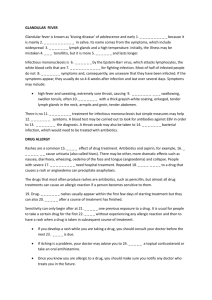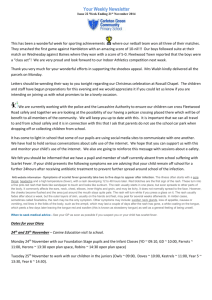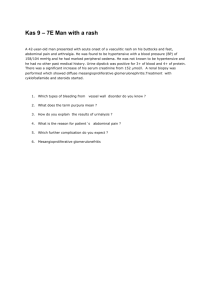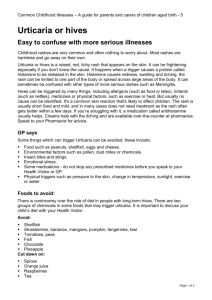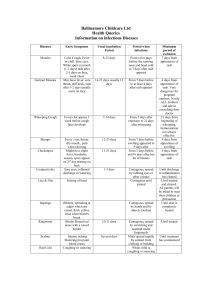common rashes
advertisement
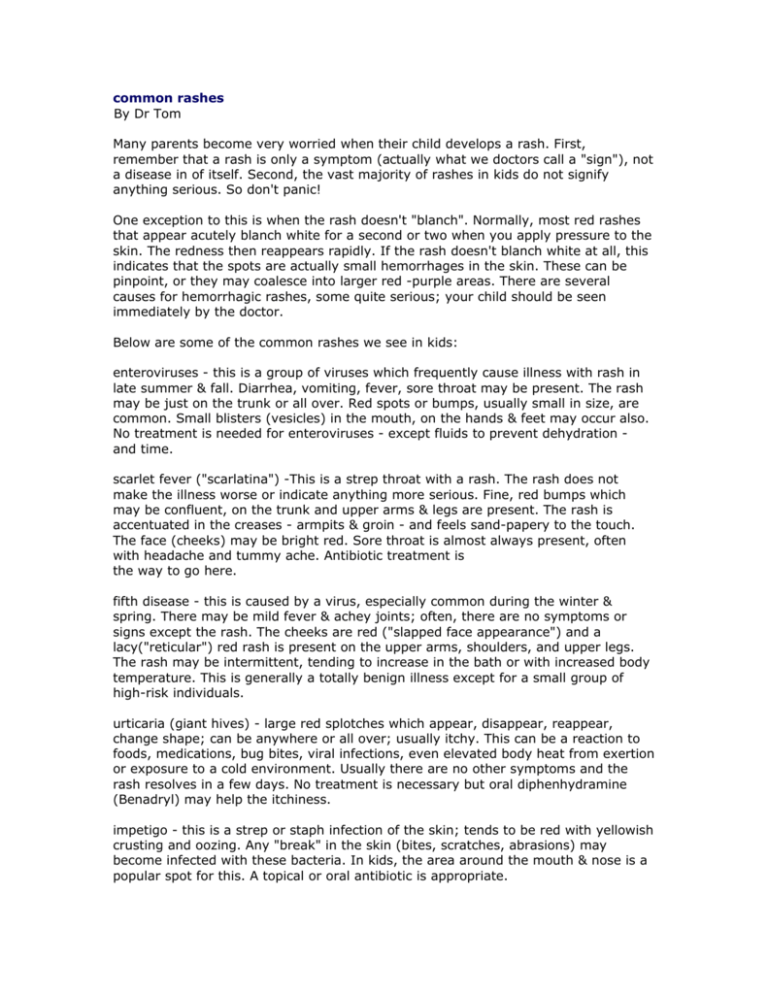
common rashes By Dr Tom Many parents become very worried when their child develops a rash. First, remember that a rash is only a symptom (actually what we doctors call a "sign"), not a disease in of itself. Second, the vast majority of rashes in kids do not signify anything serious. So don't panic! One exception to this is when the rash doesn't "blanch". Normally, most red rashes that appear acutely blanch white for a second or two when you apply pressure to the skin. The redness then reappears rapidly. If the rash doesn't blanch white at all, this indicates that the spots are actually small hemorrhages in the skin. These can be pinpoint, or they may coalesce into larger red -purple areas. There are several causes for hemorrhagic rashes, some quite serious; your child should be seen immediately by the doctor. Below are some of the common rashes we see in kids: enteroviruses - this is a group of viruses which frequently cause illness with rash in late summer & fall. Diarrhea, vomiting, fever, sore throat may be present. The rash may be just on the trunk or all over. Red spots or bumps, usually small in size, are common. Small blisters (vesicles) in the mouth, on the hands & feet may occur also. No treatment is needed for enteroviruses - except fluids to prevent dehydration and time. scarlet fever ("scarlatina") -This is a strep throat with a rash. The rash does not make the illness worse or indicate anything more serious. Fine, red bumps which may be confluent, on the trunk and upper arms & legs are present. The rash is accentuated in the creases - armpits & groin - and feels sand-papery to the touch. The face (cheeks) may be bright red. Sore throat is almost always present, often with headache and tummy ache. Antibiotic treatment is the way to go here. fifth disease - this is caused by a virus, especially common during the winter & spring. There may be mild fever & achey joints; often, there are no symptoms or signs except the rash. The cheeks are red ("slapped face appearance") and a lacy("reticular") red rash is present on the upper arms, shoulders, and upper legs. The rash may be intermittent, tending to increase in the bath or with increased body temperature. This is generally a totally benign illness except for a small group of high-risk individuals. urticaria (giant hives) - large red splotches which appear, disappear, reappear, change shape; can be anywhere or all over; usually itchy. This can be a reaction to foods, medications, bug bites, viral infections, even elevated body heat from exertion or exposure to a cold environment. Usually there are no other symptoms and the rash resolves in a few days. No treatment is necessary but oral diphenhydramine (Benadryl) may help the itchiness. impetigo - this is a strep or staph infection of the skin; tends to be red with yellowish crusting and oozing. Any "break" in the skin (bites, scratches, abrasions) may become infected with these bacteria. In kids, the area around the mouth & nose is a popular spot for this. A topical or oral antibiotic is appropriate. pustulosis - again strep or staph bacteria are the culprits; anywhere on the skin; kids' bottoms are a prime location. Small pustules with a red base. Recent strep throat or strep in the family is common. Treatment is by antibiotic. roseola - this is a viral illness, common in kids under 3 years of age. The typical story is about 3 days of high fever & irritability, then a generalized red rash all over on the 4th day. Fever is usually gone by that time. No other symptoms is the rule. Roseola is probably the most common cause of high fever - in the absence of any other symptoms -in infants & toddlers. Treatment is supportive only - fluids & fever control. molluscum contagiosum - these are small warts; round, skin-color to slightly red, with a tiny depression in the middle. May show up anywhere, usually in groups. Spread easily but disappear in 1-2 years. Molluscum warts, like all other warts, are caused by a virus; they are somewhat contagious therefore. lip-lickers dermatitis - as the name implies, this is an irritation caused by chapped skin, often in the colder months when we turn on our heat indoors and the air is dryer. Constant licking of the skin around the mouth is irritating and worsens the condition. The skin may become infected (see impetigo above). Treatment is with a good "barrier" moisterizer ointment to coat the area; apply this often - hourly if possible. If the skin looks infected, an antibiotic ointment is appropriate. amoxicillin rash - this is very common in kids on this medication. The rash may be red spots, bumps, or hivey (see urticaria above) all over. May be itchy. Many - if not most - of these "reactions" are not a true allergy; however, usual practice is to discontinue the drug if the rash is itchy or extensive. Most kids "outgrow" the tendency to react to Amoxicillin after 1-2 years. Note that the antibiotic Augmentin has amoxicillin in it. eczema - this very common rash is basically areas or patches of dry, thickened, irritated skin ranging from very mild with minor involvement to very extensive, severe dermatitis. Eczema is by definition itchy. The "scratch-itch cycle" perpetuates the inflammation by releasing histamine in the skin. Treatment is aimed at interrupting this cycle by reducing the inflammation, dryness, and the tendency to scratch. Frequent lubrication with a moisterizer ointment or cream is essential. Significant dermatitis usually requires something to reduce the inflammatory component such as a prescription-strength steroid. Avoid scented soaps and detergents, and double-rinse laundry. Eczema may appear at any age and occurs frequently in individuals or families with allergies or asthma. Kids often outgrow eczema over time. Kids with eczema are more susceptible to ringworm and warts. keratosis pilaris - this "rash" consists of numerous small bumps, most commonly on the upper outer arms, thighs, and face. Frequently seen in school-age kids & teens, especially in families with allergies. No treatment is effective or for that matter, necessary since the bumps don't (usually) itch. This condition usually lasts years but disappears eventually in most kids. ringworm - this is a superficial fungus of the skin - nothing to do with worms! Consists of a red ring, with central clearing, some scaliness usually present. May be itchy. More common in kids with allergies & eczema. Treatment is with an anti-fungal cream. poison oak - this topic is covered elsewhere on homepage. Look under "common illnesses" above.
